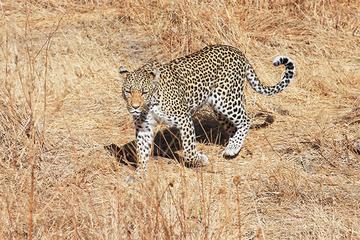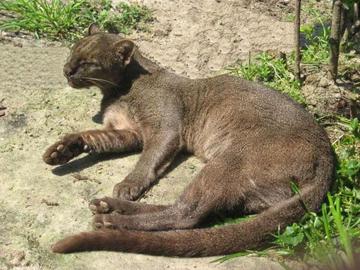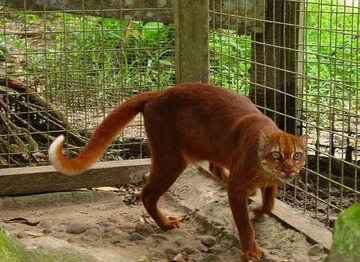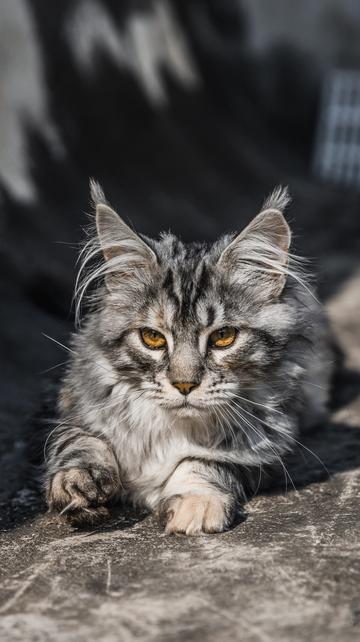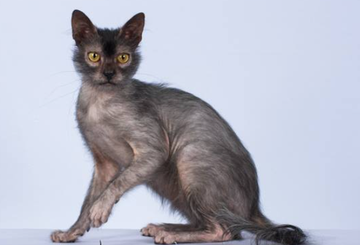电烫卷猫(原产于美国的猫)
电烫卷猫是卷发和一种富感情的个性的一个独特的组合。不可能否认爱,并且电烫卷猫将淋浴在它的所有者亦不卷曲或波浪发也做养殖如此感兴趣的喜爱。
正文
别 名:拉波猫
英文名: LaPerm
体 重: (公)
(母)
大 小: (公)
原产地:美国
猫种介绍
电烫卷猫是卷发和一种富感情的个性的一个独特的组合。你不可能否认爱,并且电烫卷猫将淋浴在它的所有者亦不卷曲或波浪发也做养殖如此感兴趣的喜爱。
1982年,在俄勒冈农场在古老狩猎附近位于,并且Wishram印地安人的渔场,六只小猫废弃物出生对谷仓猫。其中一只小猫出生完全地秃头 -- 看起来一点不喜欢她的母亲或她的littermates。
当小猫没有头发时,它在仿造一个经典平纹样式的她的皮肤有大宽间隔的耳朵和一个图纸样式。在八个星期之内小猫开始增长非常软,卷发。
在年龄小猫,现在名为“卷曲的三个到四个月”,有卷发一件充分的外套。是非常博学的关于猫,所有者什么都没有接受“突变体”作为独特和认为更多问题。
在企图未被做有选择性地养殖,但是的以后10年期间,当秃头小猫频率在任意养殖的废弃物增加了,农场的所有者开始寻找关于她异常的猫的其它信息。
她不了解遗传学或饲养和因而允许猫自由地漫游在谷仓和果树园中几年。当她发觉了怎样真实地独特这些猫是,她开始限制猫和控制饲养。
看起来卷曲基因是统治和由男性和女性运载。这位交配动物者为她在猫展示决定送进的猫和兴奋是完全无准备的引起的兴趣。所有者给了猫意味波浪或起波纹的养殖名字“LaPerm”。
相关图片
头部(40分)
形状和大小 10分
嘴部和下巴 10分
面部 4分
耳朵 8分
眼睛 8分
身体(25分)
躯干 13分
脖子 2分
腿和脚 4分
尾巴 6分
颜色和质感(5分)
背毛(30分)
长度 15分
毛波浪的卷曲 15分
BreedProfile: LaPerm
The LaPerm is a unique combination of curly hair and an affectionate personality. One cannot deny the love and affection a LaPerm will shower upon its owner nor the curly or wavy hair that also makes the breed so interesting.
The kitten that exhibited traits of the original mutation that has formed the basis for the LaPerm breed sprang from strong, healthy, domestic "barn-cat" stock. In 1982, on an Oregon farm located near the ancient hunting and fishing grounds of the Wishram Indians, a litter of six kittens was born to a barn cat. One of the kittens was born completely bald -- looking nothing like her mother or her littermates. While the kitten had no hair, it did have large wide-spaced ears and a blueprint pattern on her skin that mimicked a classic tabby pattern. Within eight weeks the kitten began to grow very soft, curly hair. At three to four months of age the kitten, now named "Curly," had a full coat of curly hair. Not being very knowledgeable about cats, the owner accepted the "mutant" as unique and thought nothing more of the matter.
During the next 10 years no attempt was made to breed selectively but as the frequency of bald kittens increased in the random bred litters, the owner of the farm began to seek additional information about her unusual cats. She had no knowledge of genetics or breeding and thus allowed the cats to roam freely throughout the barns and orchard for several years. As she became aware of how truly unique these cats were, she started to confine the cats and control the breedings. It appeared that the curly gene was dominant and carried by both males and females. This breeder was totally unprepared for the interest and excitement generated by cats she decided to enter in a cat show. The owner gave the cats the breed name "LaPerm," which means wavy or rippled.
The LaPerm can sport anything from a wavy coat to ringlet-type curls that range from tight ringlets to long corkscrew curls. The tightest curls occur on the underside of the cat, on the throat area and at the base of the ears. The longhair is generally blessed with a curly plumed tail and often exhibits a full, curly ruff. The coat is moderately soft in texture, yet each cat's coat is distinctly unique. The shorthair has more texture to the coat than does the longhaired variety. It does not have the ruff, has a "bottle-brush" type tail and the coat generally stands away from the body, parting down the middle.
The LaPerm comes in every recognized color and coat pattern. Some kittens can be born hairless, but most have short wavy hair or straight hair at birth. Kittens often go almost totally bald beginning with a spot on the tops of their heads. This process generally starts when the kittens are about two weeks old and they can be in varying stages of baldness during their first four months or so. The coat will generally come back in and will always be curly if the kitten was born curly. Coat variations throughout the life of a LaPerm range from Molting that can leave a sparse, thin coat for life to a possible full coat after neutering or spaying.
LaPerms are gentle and affectionate but also very active. Unlike many active breeds, the LaPerm is also quite content to be a lap cat. The LaPerm will often follow your lead, that is if they are busy playing and you decide to sit and relax, simply pick up your LaPerm and sit down with it and it will stay on your lap devouring the attention you give it. LaPerms seek human contact and will purr as soon as they become aware of your presence. They are inquisitive by nature and always want to know what is going on around them. They will reach for your face with their paws and rub their faces against your head, neck and face.
LaPerms are truly different from any other breed of cat because of their unique combination of appearance and people oriented personalities. The breed has captivated nearly everyone who has the opportunity of seeing one. Once a LaPerm graces your household you will be hard pressed to think of living with any other breed and may find it a necessity to have more than one. Cradling a LaPerm in your arms can touch your senses. Running your fingers through the sensuous coat becomes automatic and you won't want to stop. Listening to the purr and seeing the intelligence unfold as you teach your cat tricks such as fetching will give you an unmatched feeling of love and respect for the breed.
Pricing on LaPerms usually depends on type, applicable markings and bloodlines distinguished by Grand Champion (GC), National, National Breed and/or Regional winning parentage (NW, BW, RW) or of Distinguished Merit parentage (DM). The DM title is achieved by the dam (mother) having produced five CFA grand champion/premier (alter) or DM offspring, or sire (father) having produced fifteen CFA grand champion/premier or DM offspring. Usually breeders make kittens available between twelve and sixteen weeks of age. After twelve weeks, kittens have had their basic inoculations and developed the physical and social stability needed for a new environment, showing, or being transported by air. Keeping such a rare treasure indoors, neutering or spaying and providing acceptable surfaces (e.g. scratching posts) for the natural behavior of scratching (CFA disapproves of declawing or tendonectomy surgery) are essential elements for maintaining a healthy, long and joyful life.
Breed Standard: LaPerm
The LaPerm is eligible to be shown in the Provisional Class.
POINT SCORE
HEAD (40)
Size and Shape .......................... 10
Muzzle and Chin ......................... 10
Profile ................................. 4
Ears .................................... 8
Eyes .................................... 8
BODY (25)
torso ................................... 13
Neck .................................... 2
Legs & Feet ............................. 4
Tail .................................... 6
COLOR AND PATTERN ............................... 5
COAT (30)
Texture and Length ...................... 15
Curl or Waviness ........................ 15
GENERAL: the LaPerm is a naturally occurring mutation producing both long and shorthaired cats. It is medium sized, curly coated with semi-foreign type. All colors are acceptable. All parts of the body are in harmony with the size of the cat. There is evidence of surprising weight for size. The cat is alert and seems to be walking tall on his feet. Males may have a curlier coat but not always. Females are generally smaller than males.
HEAD: the skull is a modified wedge with rounded Contours. There is a gentle convex curve rising from the bridge of the nose to the brow. the skull is a modified wedge, slightly rounded with gentle contours. Whisker pads should appear full and rounded, with long whiskers.
MUZZLE: broad with rounded contours and moderate to strong whisker pinch. Chin strong and firm presenting a perpendicular line down from the tip of the nose. Allowances should be made for jowls on mature males.
PROFILE: slight dip to nose just below bottom of eye, then continuing straight to tip of nose. Dip must be felt for, as it can appear straight. Forehead should be a flat plane to the top of the head, then smooth gentle curve back over top of head flowing into neck.
EARS: placed to continue the modified wedge of the head, slightly flared and cupped, medium to large. Full furnishings and earmuffs with lynx tipping is preferred on longhair variety but not required on the shorthair variety.
EYES: medium large and expressive, almond in shape at rest and rounder when alert. Set moderately far apart and slightly slanted toward base of ear. Eye color has no relation to coat color.
BODY: medium in size, semi-foreign, medium boning with hips slightly higher than shoulders.
NECK: carried erect, medium long in length in proportion to body
LEGS and FEET: medium long to match body length. Forelegs may be slightly shorter than hind legs. As with body, medium fine boning with rounded feet.
TAIL: in proportion to body, tapering from base to tip.
COAT-LONGHAIR: Texture and length: medium-long to long, both males and females may have ruff on neck at maturity. The coat should be free of matting, so it should not be too thick and heavy. The tail is plumed with some curling. The coat is springy, light and airy. The feel may vary among individual cats and/or color. Curl or waviness: curly or wavy, curl is preferred. The coat should be loose and bouncy and should stand away from the body, a coat you can run your fingers through to the skin. The coat is light and airy enough to part with a breath. The coat will have an almost unkempt appearance (the "Gypsy Shag" look). Tightest curls are in the ruff and the base of the ears; longest curls are in the ruff, base of the ears, and at the base of the tail. The coat may vary in length and fullness according to the season and maturity of the cat. At times this coat will part naturally down the middle of the back.
COAT-SHORTHAIR: Texture and length: short to approximately medium-long. The tail is not plumed but hair may be wavy. The coat is springy, light and airy. The texture may be harder than longhair and will vary among individual cats and/or colors. The coat will stand away from the body with waves over most of the cat. Curl or waviness: curly or wavy. Is not required to have a ruff, ringlets or earmuffs. The tail will be like a bottlebrush. At times this coat will part naturally down the middle of the back.
PENALIZE: lack of ear furnishings on the longhair LaPerm, crossed eyes or non-visible tail faults.
DISQUALIFY: cobby body, short legs, incorrect number of toes, visible tail faults, straight hair.
COLORS:
COAT COLOR: any genetically possible color or combination of colors is allowed. EYE COLOR: eye color can be copper, gold, yellow, green or blue. There is no correlation required between coat color and eye color.
WHITE: pure glistening white. Nose leather and paw pads: pink.
BLACK: dense coal black from roots to tip of fur. Nose leather and paw pads: black.
BLUE: one level tone most important, light shade preferred. Nose leather and paw pads: blue.
RED: deep, clear, without markings or ticking. Nose leather and paw pads: brick red.
CREAM: one level shade of buff cream without markings. Nose leather and paw pads: pink.
CHOCOLATE: rich, warm chocolate-brown, one level tone. Nose leather and paw pads: brown.
CINNAMON: light reddish brown, the color of a cinnamon stick, distinctly warmer, lighter and redder than chocolate. Nose leather and paw pads: tan to pinkish beige.
FAWN: light lavender with pale cocoa overtones. Nose leather and paw pads: a light shade of dusty rose pink (no blue or lavender tones).
LAVENDER: one level shade, frosty, grey pink. Nose leather and paw pads: lavender pink.
SHADED PATTERN: undercoat white with a mantle of color tipping, even with no marks, shaded down from sides, face and tail from dark on the ridge to white on the chin, stomach and under the tail. Legs to be the same tone as the face. Rims of eyes, lips and nose: outlined with tipping color.Nose leather and paw pads as defined below.
SHADED SILVER: Nose leather: brick red. Paw pads: black.
BLUE SHADED: Nose leather and paw pads: blue or blue with pink tone.
CHOCOLATE SHADED: Nose leather and paw pads: pink.
CINNAMON SHADED: Nose leather and paw pads: tan to pinkish beige.
LAVENDER SHADED: Nose leather and paw pads: lavender pink.
FAWN SHADED: Nose leather and paw pads: pink.
CREAM SHADED: Nose leather and paw pads: pink.
RED SHADED: Nose leather and paw pads: rose pink.
tortoiseshellSHADED: Nose leather and paw pads: rose pink to black.
BLUE-CREAM SHADED: Nose leather and paw pads: rose pink to blue.
CHOCOLATE TORTOISESHELL SHADED: Nose leather and paw pads: as in solids, may be mottled with pink.
LAVENDER-CREAM SHADED: SHADED: Nose leather and paw pads: lavender pink.
GOLDEN SHADED: undercoat rich warm cream with black tipping. Nose leather and paw pads: black.
chinchilla PATTERN: undercoat pure white. Coat on back, flanks, head and tail sufficiently tipped with specific marking color (i.e., black, blue, red, cream, tortoiseshell, etc.) to give the characteristic sparkling appearance. Legs may be slightly shaded with tipping. Chin, stomach and chest, pure white. Rims of eyes, lips and nose outlined with marking color. Nose leather: appropriate to pattern and marking color (black/brick red; blue/old rose; etc.). Paw pads: appropriate to pattern and marking color.
GOLDEN CHINCHILLA: undercoat rich warm cream, tipped with black. Nose leather and paw pads: black.
SMOKE PATTERN: white undercoat more deeply tipped with specified marking color. Cat in repose appears to be of marking color. In motion, the white undercoat is apparent. Points and mask of marking color with narrow band of white at base of hairs next to skin which may be seen only when fur is parted. Nose leather and paw pads: appropriate to pattern and marking color (see below).
BLACK SMOKE: Nose leather and paw pads: black.
BLUE SMOKE: Nose leather and paw pads: blue.
RED SMOKE CAMEO: Nose leather and paw pads: rose.
CHOCOLATE SMOKE: Nose leather and paw pads: brown or pink.
CINNAMON SMOKE: Nose leather and paw pads: tan to pinkish beige.
FAWN SMOKE: Nose leather and paw pads: lavender pink.
LAVENDER SMOKE: Nose leather and paw pads: lavender pink.
CREAM SMOKE: Nose leather and paw pads: pink.
TORTOISESHELL SMOKE: Nose leather and paw pads: black mottled with pink.
BLUE-CREAM SMOKE: Nose leather and paw pads: blue mottled with pink on nose and paw pads.
CHOCOLATE TORTOISESHELL SMOKE: Nose leather and paw pads: mottled with pink on nose and paws.
LAVENDER-CREAM SMOKE: Nose leather and paw pads: grey-pink mottled with pink.
CLASSIC TABBY PATTERN: markings dense, clearly defined and broad. Legs evenly barred with bracelets coming up to meet the body markings. Tail evenly ringed. Several unbroken necklaces on neck and upper chest, the more the better. frown marks on the forehead form intricate letter 揗? Unbroken line runs back from outer corner of eye. SWIRLS on cheeks. Vertical lines over back of head extend to shoulder markings which are in the shape of a butterfly with both upper and lower wings distinctly outlined and marked with dots inside outline. Back markings consist of a vertical line down the spine from butterfly to tail with a vertical stripe paralleling it on each side, the three stripes well separated by stripes of ground color. Large solid blotch on each side to be encircled by one or more unbroken rings. Side markings should be the same on both sides. Double vertical row of buttons on chest and stomach.
MACKEREL TABBY PATTERN: markings dense, clearly defined and all narrow pencillings. Legs evenly barred with narrow bracelets coming up to meet the body markings. Tail barred. Necklaces on neck and chest distinct; like so many chains. Head barred with an 揗?on the forehead. Unbroken lines running back from the eyes. Lines running sown the head to meet the shoulders. Spine lines run together to form a narrow saddle. Narrow pencillings run around body.
SPOTTED TABBY PATTERN: markings on the body to be spotted. Spots can be round, oblong or rosette-shaped. Any of these are of equal merit but the spots, however shaped or placed, should be distinct. Spots should not run together in a broken mackerel pattern. A dorsal stripe runs the length of the body to the tip of the tail. The stripe is ideally composed of spots. The markings of the face and forehead shall be typically tabby markings. Underside of the body to have 搗est buttons? Legs and tail are barred.
TICKED TABBY PATTERN: body hairs to be ticked with various shades of marking color and ground color. Body when viewed from top to be free from noticeable spots, stripes, or blotches, except for darker dorsal shading. Lighter underside may show tabby markings. Face, neck, legs, and tail may show tabby striping.
PATCHED TABBY PATTERN: a patched tabby (torbie) is an established Classic, Mackerel, Spotted or Ticked Tabby in silver, brown, blue, chocolate, lavender, cinnamon, or fawn with patches of red and/or cream clearly defined on both the body and extremities; a blaze on the face is desirable. Nose leather and paw pads: same as non-patched tabbies, may be mottled with pink.
SILVER TABBY: ground color, including lips and chin, pale clear silver. Markings dense black. Nose leather: brick red. Paw pads: black.
BROWN TABBY: ground color brilliant coppery brown. Markings dense black. Lips and chin the same shade as around the eyes. Back of legs black from paw to heel. Nose leather: brick red. Paw pads: black or brown.
BLUE TABBY: ground color, including lips and chin, pale bluish ivory. Markings a very Deep Blue affording a good contrast with ground color. Warm fawn overtones or patina over the whole. Nose leather and paw pads: blue.
RED TABBY: ground color red. Markings deep, rich red. Lips and chin red. Nose leather and paw pads: brick red to pink
CREAM TABBY: ground color, including lips and chin, very pale cream. Markings buff or cream sufficiently darker than the ground color to afford good contrast but remaining within the dilute color range. Nose leather and paw pads: pink.
CHOCOLATE TABBY: ground color is warm fawn, markings are rich chestnut brown. Nose leather: chestnut or pink rimmed with chestnut. Paw pads: cinnamon.
CHOCOLATE SILVER TABBY: ground color, including lips and chin, is silver. Markings chocolate. Nose leather: chocolate, or pink rimmed with chocolate. Paw pads: coral pink.
CINNAMON TABBY: ground color fawn. Markings light reddish brown, the color of a cinnamon stick, distinctly warmer, lighter and redder than chocolate. Nose leather and paw pads: tan to pinkish beige.
FAWN TABBY: ground color pale off white. Markings light lavender with pale cocoa overtones. Nose leather and paw pads: a light shade of dusty rose pink (no blue or lavender tones).
LAVENDER TABBY: ground color is pale lavender. Markings are a rich lavender, affording good contrast with ground color. Nose leather: lavender, or pink rimmed with lavender. Paw pads: lavender-pink.
LAVENDER SILVER TABBY: ground color, including lips and chin a cold, clear silver. Markings solid lavender. Nose leather: lavender or pink rimmed with lavender. Paw pads: lavender-pink.
CAMEO TABBY: ground color off-white. Markings red. Nose leather and paw pads: rose.
BLUE-SILVER, CREAM-SILVER TABBY: tabby pattern with colors and leathers same as for corresponding shaded colors.
TORTOISESHELL: black mottled or patched with red. Blaze on face is desirable. Nose leather and paw pads: black or brown mottled with pink.
BLUE-CREAM: blue mottled or patched with cream. Blaze on face is desirable. Nose leather and paw pads: blue mottled with pink.
CHOCOLATE TORTOISESHELL: rich chocolate brown mottled or patched with red. Blaze on face is desirable. Nose leather and paw pads: cinnamon mottled with pink.
LAVENDER-CREAM: lavender mottled or patched with cream. Blaze on face is desirable. Nose leather and paw pads: lavender pink mottled wih pink.
calico: white with unbrindled patches of black and red. White predominant on underparts. Any combination of dominant colors of solid, shaded, smoke, tabby, or pointed and white.
VAN CALICO: white cat with dominant patches of color (see list under CALICO) confined to extremities. One or two small patches of color on body allowable.
DILUTE CALICO: white with unbrindled patches of cream and blue. White predominant on underparts. Any combination of dilute colors of solid, shaded, smoke, tabby or pointed and white.
VAN DILUTE CALICO: white cat with patches of dilute colors (see list under DILUTE CALICO) confined to the extremities. One or two small patches of color on body allowable.
BI-COLOR: solid, shaded, smoke, tabby, parti or pointed and white.
VAN BI-COLOR: solid, shaded, smoke, tabby, parti or pointed and white. Color confined to extremities: head, legs, tail. One or two small patches on body allowable.
SEAL POINT: body even pale fawn to cream, warm in tone, shading gradually into lighter color on the stomach and chest. Points deep seal brown. Nose leather and paw pads: seal brown.
CHOCOLATE POINT: body ivory with no shading. Points milk chocolate color, warm in tone. Nose leather and paw pads: cinnamon pink.
BLUE POINT: body bluish-white, cold in tone, shading gradually to white on stomach and chest. Points blue. Nose leather and paw pads: slate blue.
LAVENDER POINT: body glacial white with no shading. Points frosty grey with pinkish tone. Nose leather and paw pads: lavender pink.
LAVENDER-CREAM POINT: body glacial white with no shading. Points lavender with patches of cream. Nose leather and paw pads: lavender and pink.
ED POINT: body creamy white. Points deep orange flame to deep red. Nose leather and paw pads: flesh or coral pink.
CREAM POINT: body creamy white with no shading. Points buff cream with no apricot. Nose leather and paw pads: flesh pink or salmon coral.
TORTIE POINT: body creamy white or pale fawn. Points seal with unbrindled patches of red. Blaze of red on face desirable. Nose leather and paw pads: seal brown with flesh and/or coral pink mottling to conform with colors on points.
CHOCOLATE-TORTIE POINT: body ivory with no shading. Points chocolate with unbrindled patches of red. Nose leather and paw pads: chocolate with mottling to conform with point color.
BLUE-CREAM POINT: body bluish white or creamy white, shading gradually to white on the stomach and chest. Points blue with patches of cream. Nose leather and paw pads: slate-blue, pink or a combination of slate-blue and pink.
SILVER POINT: body ivory to glacial white. Points shaded silver. Rims of eyes, lips and nose outlined with black. Nose leather: brick red. Paw pads: black.
LYNX POINTS: body color appropriate to marking and ground color. Mask must be clearly lined with dark stripes vertical on forehead with classic 揗?on forehead, horizontal on cheeks and dark spots on whisker pads clearly outlined in dark color edges. Inner ear light with thumbprint on outer ear. Markings dense, clearly defined and broad. Legs evenly barred with bracelets. Tail barred. No striping or mottling on body, but consideration given to shading in older cats.
SEAL LYNX POINT: Nose leather and paw pads: seal.
BLUE LYNX POINT: Nose leather and paw pads: blue or brick red.
CHOCOLATE LYNX POINT: Nose leather and paw pads: cinnamon, or pink rimmed with cinnamon
LAVENDER LYNX POINT: Nose leather and paw pads: lavender pink or pink rimmed with lavender.
RED LYNX POINT: Nose leather and paw pads: flesh or red.
CREAM LYNX POINT: Nose leather and paw pads: pink or pink rimmed with salmon coral.
ILVER LYNX POINT: Nose leather: coral pink or brick red lined with black. Paw pads: black or seal.
NATURAL MINK: body medium brown, shading to lighter hue on the underparts. Ruddy highlights acceptable. Points are dark brown. Nose leather: dark brown corresponding to the intensity of the point color. Paw pads: medium to dark brown (may have rosy undertone).
CHAMPAGNE MINK: body buff-cream, points medium brown. Nose leather: cinnamon-brown. Paw pads: cinnamon-pink to cinnamon-brown.
BLUE MINK: body blue-grey, shading to lighter hue on the underparts. Fawn overtones permissible. Points slate blue, distinctly darker than body color. Nose leather and paw pads: slate grey (may have rosy undertone).
PLATINUM MINK: body pale, silvery grey with warm overtones. Not white or cream. Points frosty-grey. Nose leather and paw pads: lavender-pink to lavender-grey. ABLE SEPIA: rich warm sable brown, shading almost imperceptibly to a slightly lighter hue on the underparts, but otherwise without shading, barring or markings of any kind (kittens are often lighter in color). Nose leather and paw pads: brown.
CHAMPAGNE SEPIA: warm honey beige, shading to a pale golden tan underside. Slight darkening on ears and face permissible. Nose leather: light warm brown. Paw pads: warm pinkish tan.
BLUE SEPIA: medium blue with warm fawn undertones, shading almost imperceptibly to a slightly lighter hue on the underparts, but otherwise without shading, barring or marking of any kind. Nose leather and paw pads: slate grey.
PLATINUM SEPIA: pale, silvery grey with pale fawn undertones, shading almost imperceptibly to a slightly lighter hue on the underparts, but otherwise without shading, barring or markings of any kind. Nose leather and paw pads: lavender pink.
OLC(OTHER LAPERM COLORS): any other genetically possible color or pattern. Cats with no more than a locket and/or button do not qualify for this class; such cats shall be judged in the color class of their basic color with no penalty for such locket or button.
The following information is for reference purposes only and not an official part of the CFA Show Standard.
LaPerm Color Class Number
All Colors (Longhair & Shorthair) 6000 6001
(Shorthair Specialty Ring)
LaPerm allowable outcross breeds: Domestic longhair and domestic shorthair. Kittens born on or after January 2010 may have only LaPerm parents.


